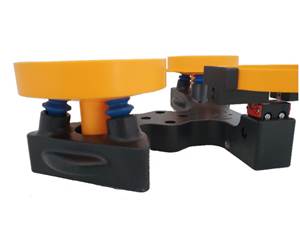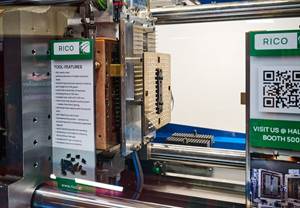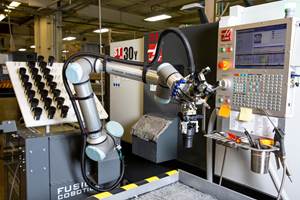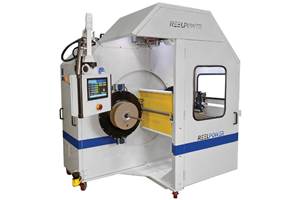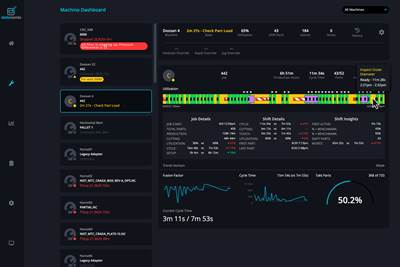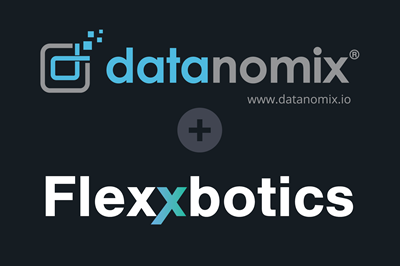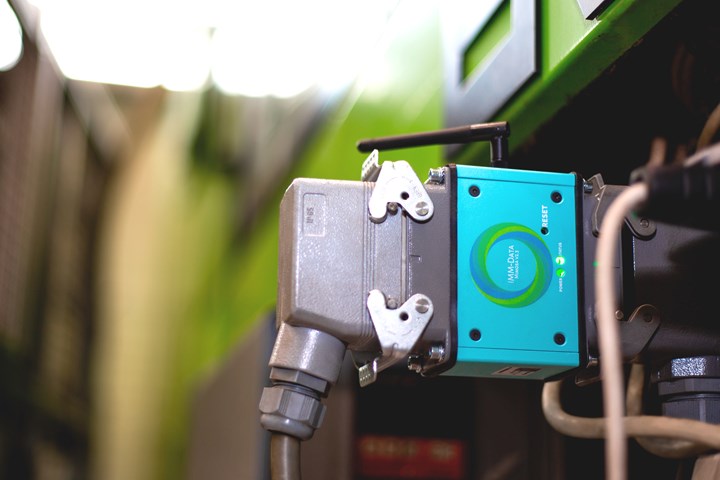
Special hardware plugs into an injection machine and its accompanying robot, sending monitored data via WiFi to the cloud for automated analysis by IMM-Data software. (Photos: IMM-Data)
Some people call it Industry 4.0, some call it the Internet of Things (IoT) or “smart factories.” By any name, it’s the new era of real-time manufacturing visibility, which is bringing new opportunities for increased productivity, efficiency and cost control to manufacturers of all types and sizes. “Production data is profit. Everyone wants to get into it, but the software suppliers have been targeting big enterprises that have time and money and expertise to implement big, complex data systems.” That’s the situation that Kristof Hauser wants to change. His six-year-old startup firm in Hungary is one of a small handful of new firms that are offering affordable, preconfigured machine-monitoring systems that are quick to implement and easy to use by smaller firms without IT staffs.
“Production data is profit.”
Hauser is founder and CEO of IMM-Data, which is short for Industrial Machine-to-Machine Data. He formerly worked for Simon Plastics, one of Hungary’s largest processors, with nearly 100 injection molding machines of 25 to 1100 tons. While there, Hauser worked on developing an in-house data-collection system. His employer reportedly netted annual savings of $250,000 from reduced scrap and downtime, improved OEE, and optimized production through quicker decision making with real-time online data. Now Hauser is offering his own system so other processors can reap similar benefits. His early customers include three Hungarian injection molders: Deltaplast, Plasticor and BTNyloplast. Hauser is now offering his system to the U.S. market.
Plug & Play
Hauser describes the IMM-Data system as “MES-lite.” It includes many of the functions of manufacturing execution systems (MES) systems, but excludes some, such as order scheduling. What it does include are collection and presentation of real-time statistics on OEE, throughput, cycle time, changeover time, downtime reasons, capacity utilization, schedule or production completion, maintenance schedule, productivity, customer rejects/returns, and quality measurements. Additional features such as reject reasons are in development. The system can send alerts to designated personnel via email or text message.
There’s no upfront investment and the system should be up and running in a few days.
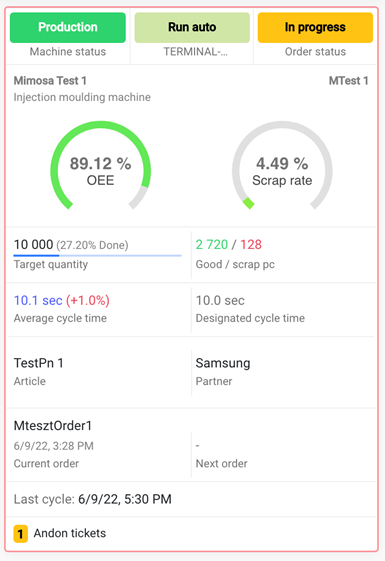
Sample user dashboard accessible online showing key production data by machine. Data for several machines can also be shown side by side with color coding to show at a glance which machines need attention.
His system reportedly works with any type, make or age of machinery, including robots and auxiliaries, that can be connected via PLC signals and communication protocols such as Euromap 63 or 67 and OPC-UA. It includes both hardware and software. The hardware is a “plug-and-play” device that connects to the monitored device(s) — for example, an injection machine and its parts-removal robot — and transmits monitored data via WiFi to the cloud, where IMM-Data software analyzes it and turns it into useful color-coded (red-yellow-green) metrics on a customer’s individual dashboard. The dashboard shows the machine layout in the plant and each machine’s status at a glance. Clicking on a machine opens up complete data on the machine’s production efficiency and job progress. Several machines’ job statistics can also be displayed on one screen. Other analysis screens show Pareto charts of downtime causes and scrap rate and scrap value by machine or job. These charts allow users to prioritize attention to the major causes of lost production and revenue. Dashboards are not yet user-configurable, though that’s in development; for now, they can be customized by IMM-Data.
The hardware and software are available on an annual subscription basis, so there is no upfront investment and thus little risk for new users. In addition, the first month’s use is at a 50% discounted rate. For a “typical” 20-machine plant, Hauser estimates that installation should take no more than two days to get the system up and running, for an annual cost of around €30,000. Installation comes with training (“coaching”) on how to use the monitoring data.
IMM-Data is working on a joint project with a Hungarian university and a large injection molder to enhance the system. The initial goal is to add PLC capability to the plug-in monitoring hardware so that it can read both digital and analog data such as from temperature sensors and I/O signals. Other future goals include adding extrusion monitoring capability.
Related Content
Ensuring Repeatability: The Key to Effective Injection Molding Automation
One of automation’s key promises is repeatability: the same movement to the same location, time and time again. But to achieve that, all elements involved — robot, machine, EOAT, mold — must be in and stay in alignment.
Read MoreLSR Advances in Dispensing, Tooling and Automation
At Fakuma 2023, Sumitomo (SHI) Demag’s LSR injection molding machines showcased advances from itself and partners Reinhardt-Technik, Rico and Sepro.
Read MoreFour Industry 4.0 Tech Adoption Insights from Indiana Plastics Manufacturers
As more plastics manufacturers step into the Fourth Industrial Revolution, insights have emerged about how best to approach the digital transformation journey.
Read MoreAutomation in Winding, Coiling and Cutting for Reduced Labor and Increased Safety and Consistency
Reel Power will demonstrate how its automatic winding system works in concert with extrusion and automated pick and place.
Read MoreRead Next
Machine Monitoring System Adds ‘Hands-Free’ Downtime Analysis
Get automated analysis of downtime amounts and reasons without any operator input.
Read MoreMachine Monitoring Becomes Simpler And More Affordable Than Ever
A new application of an established technology makes production monitoring accessible to any manufacturer, with any type of equipment, and in almost no setup time.
Read MoreProduction Monitoring for Cobots
Datanomix partners with Flexxbotics to provide automated production monitoring of Universal Robots cobots in production cells.
Read More









